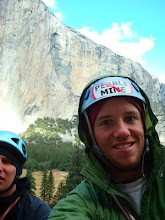This weekend though, was redemption!
I needed my Level II Avalanche Certification to work on Denali this summer. Luckily, The Alaska Avalanche School had ONE spot left, so I quickly snagged it up.
The first two days were spent up north in Hatcher Pass. We learned lots of snow science...how to read and identify grain types, weak layers, etc.
The real education came on Sunday though. The group headed down to Turnagain Pass to study a more maritime snow pack and instead we ended up studying the powerful and deadly ramifications of a MASSIVE avalanche from the day before.
Seven feet of snow had fallen in several days over a layer of facets (weak, unstable snow layer caused by moisture and cool temperatures over time). A tourist skier from Oregon triggered a gigantic slide on the southwest aspect of Sunburst that propagated nearly 1/2 mile wide. The crown (the top of the avalanche slide) was 10 feet thick at the highest part. The avalanche took the skier more than 1500 feet down the face, then over a huge ditch, and up onto the opposing valley wall onto the face of Magnum. This avalanche then triggered another sympathetic avalanche off of Magnum.
Rescuers were unable to locate the victim for more than 30 minutes. After this amount of time, survival rates plummet exponentially. Incredibly the victim was found after nearly 40 minutes. Unconscious and blue in the face, rescuers thought he was dead. He soon gained consciousness and was talking. After a helicopter ride to the hospital, he was released without even sustaining any injuries.
So, we as students spent all of Sunday surveying and analyzing the massive slide. It was quite a classroom setting. We learned that he was the sixth skier down the face. It was caused by him skiing off a rock, which was right by the thin part of the snow layer.
It was amazing to see skiers disregarding the signs and skiing similar terrain on similar aspects as well as snowmachiners highmarking across the valley near Seattle Ridge. It seemed quite ignorant since the rescuers had flown out with a corpse and a victim from two separate avalanches less than 24 hours beforehand.
Ultimately, we learned to be humble and use our instincts. The guy should have become a statistic. He was lucky and I learned a lesson from surveying the scene that I hope I never have to experience firsthand.
For more information and pictures of the slide taking place, go to the Chugach Avalanche Forecasting Page .
Massive props to all of the rescuers who were on the scene to help!
And...TAKE AN AVALANCHE COURSE! BE SMART, BE SAFE, and DON'T BE A STATISTIC!

2 comments:
Clint,
Nice blog, interesting, well written and great photos. We in Washington State also hear and read of skiers and others that trigger avalanches that result in personal injury and often death. Hope your training keeps you safe and you are able to use your knowledge to inform others that may be exposing themselves and others to the dangers of avalanches. Good luck with guiding Denali and write more soon.
ELK
Post a Comment